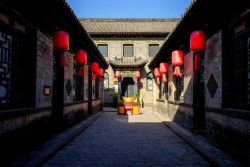You have no items in your shopping cart.


Introducing Qiao's Family Compound
Qiao’s Family Compound is also known as Qiao’s Grand Courtyard. Qiao’s Family Compound is a remarkable courtyard house in Qi County, located 41 km (25.4 miles) northwest of Pingyao and 57 km (35.4 miles) south of Taiyuan. This expansive estate was formerly the residence of the prominent financier Qiao Zhiyong (乔致庸, 1818-1907), the most notable member of the Qiao family.
Considered by architects as one of the best-preserved examples of grand private residences in northern China, Qiao’s Family Compound sprawls across an impressive 9,000 square meters (2.2 acres). This architectural marvel, designed in the shape of the Chinese xi character (囍, symbolizing “double happiness”), boasts a complex and harmonious layout. Within its walls, 313 rooms are distributed among 6 large courtyards, 20 smaller ones, and various gardens. The indoor spaces alone encompass a remarkable 4,000 square meters (about 1 acre). Visitors are continually impressed by both its grand scale and the fine craftsmanship evident throughout. Detailed brick carvings, woodwork, murals, and inscribed tablets are showcased throughout the estate, while the diverse roof styles and the over 140 uniquely designed chimneys are of particular interest.
The Qiao’s Family Compound gained international recognition as the main filming location for Zhang Yimou’s renowned film “Raise the Red Lantern.” Its cultural significance was further enhanced when it served as the setting for a 2006 Chinese television series titled “Qiao’s Grand Courtyard.”
Qiao's Family Compound Fast Facts
• AKA: Qiao’s Grand Courtyard
• Chinese Name: Qiao Jia Da Yuan 乔家大院
• Best Time to Visit: Apr, May, Sept & Oct
• Recommended Visiting Hours: 2 - 3 x hours
• Opening Hours: 8:30 – 18:00 (Apr – Oct), 8:00 – 17:15 (Nov – Mar)
• Entrance Fee: CNY115
• Address: Qiaojiabu Village, Dongguan Township, Qixian County, Shanxi Province
History of the Qiao's Family Compound
Qiao’s Family Compound, a symbol of the family’s enduring legacy, was established during Emperor Qianlong’s reign (1736-1796). Qiao Quanmei (乔全美), father of future patriarch Qiao Zhiyong (乔致庸), initiated the construction of this grand residence. Building upon his father’s foundation, Qiao Zhiyong’s leadership propelled the family’s fortunes to their peak. His business acumen led to the expansion of the Qiao clan’s empire, controlling over 200 businesses nationwide, including banks, pawnshops, teahouses, and granaries. This prosperity funded the compound’s most significant expansion.
How to Get to Qiao's Family Compound
• The Qiao’s Family Compound is located approx. 41 km (25.4 miles) away from Pingyao County.
• Charter a car/bus from GoGrandChina to enjoy a hassle free private transfer from hotels in Pingyao to Qiao's Family Compound.